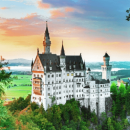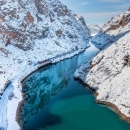
A journey to Portugal's stunning northeast corner
Rachel Schnalzer, Senior Writer
27 March 2025
On a warm night last October, under a dark sky alight with stars, I travelled back in time. All the way back to 22,000 BCE, to be precise.
Together with a group of fellow writers, I spent the previous week travelling by train from Great Britain to Portugal. Our ultimate destination: The Côa Valley, an endlessly fascinating region in Portugal’s northeast corner.
On the second-to-last night of our trip, we visited the Côa Valley Archaeological Park, a treasure trove of open-air, prehistoric rock art alongside the rushing Côa River. With a flashlight illuminating the ragged rock faces, our guide pointed out the shapes of horses, deer and aurochs, a now-extinct ox-like species.
Why did the people who once inhabited the Côa Valley carve the animals’ shapes in overlapping forms, over and over in the rock surface?
As our guide explained, not much is certain about the early humans who left behind these carvings. But looking at the animal shapes, made thousands of years ago, I felt a connection beginning to form between our group of modern-day travellers and the ancient rock artists.
“They heard the same river and saw the same stars,” I heard one of my companions murmur quietly, as we looked up at the constellations in the night sky.
In this itinerary, you’ll learn how to travel from London all the way to Côa Valley by train. Stop in the places my fellow travellers and I explored on our way to Portugal – or extend your journey with breaks in less-visited places such as Bayonne, St. Jean de Luz and beyond.
This journey was taken as part of Intrepid Travel’s “Diversifying Travel Media” press trip, a collaboration between Intrepid Travel and Eurail. Learn more about Eurail’s partnership with Intrepid Travel.
- London, Great Britain
- San Sebastián/Donostia, Spain
- León, Spain
- Vigo, Spain
- Porto, Portugal
- Côa Valley, Portugal
€ 318
Trip details

The British Library has a collection of more than 170 million items, including books, maps, newspapers, and beyond.
London, Great Britain
Why it's worth visiting:
Our journey began at St. Pancras International Station, in the heart of central London. Before boarding your train and travelling across the English Channel to France, allow yourself time to experience nearby neighbourhoods, such as Bloomsbury, Camden and Primrose Hill.
What to do:
- Just across the street from St. Pancras International, the British Library is a convenient place to explore before embarking on your Interrail trip. The library’s Treasures Gallery, which travellers can visit free of charge, has something for everyone, from the earliest surviving copy of the epic Beowulf to handwritten lyrics penned by members of The Beatles.
- Continue your literary tour of London at nearby Word on the Water, a bookstore located on a 100-year-old barge floating on Regent's Canal.
- Enjoy some fresh air before your train journey begins. Just down St. Regent’s Canal are the “Green Steps,” perfect for relaxing with a coffee or tea before you head inside St. Pancras to continue your adventure.
Suggested route
-
From: London St. Pancras International
-
To: Hendaye (Note: you will need to take a 35-minute train ride from Hendaye over the border to San Sebastián/Donostia. It is not included in the Pass network and costs €2.75 for a one-way ticket.)
-
Average travel time: 9 hours
-
Transfers: 2
-
Seat reservations: Required

Mount Urgull, covered in lush vegetation, overlooks Zurriola Beach and the city's Old Quarter.
San Sebastián/Donostia, Spain
Why it's worth visiting:
Crescent-shaped beaches, lush hills and historical city streets awaited us in San Sebastián, also referred to as Donostia. After arriving at Amara station, we made a beeline to the centre, eager to sample pintxos, the city’s most famous culinary highlight.
What to do:
- Pintxos, small dishes served in restaurants and bars across San Sebastián/Donostia, showcase the variety of Basque cuisine. Begin hungry and hop from one restaurant to the next, trying a few different pinxtos at each stop.
- Learn more about Basque history at the San Telmo Museoa, located in a former convent from the 1500s in the city’s scenic Old Town.
- Spend a morning surfing the waves at Zurriola Beach, a popular stretch of sand along the city’s Gros district. A number of nearby surf shops offer lessons and rentals, making Zurriola Beach the perfect beginner-friendly spot.
Suggested route
-
From: San Sebastián/Donostia
-
To: León
-
Average travel time: 6 hours
-
Transfers: 1
-
Seat reservations: Required

The Cathedral's cloister is home to a museum which includes a noteworthy collection of Romanesque art.
León, Spain
Why it's worth visiting:
On the journey to our next destination, we left behind the green mountains and coastline of Basque Country and travelled into the rocky hills and arid plains of Castile and León. The city of León, steeped in medieval history, has a long been a destination for travellers – after all, the city is on the 1,000-year-old Camino de Santiago pilgrimage route, which hundreds of thousands of trekkers hike each year.
What to do:
- Stepping into León’s Cathedral, with over 700 stained glass windows, is like stepping inside a kaleidoscope. Construction on the Gothic masterpiece began in the 1100s and today, it continues to attract travellers to the centre of León.
- After sightseeing, enjoy some tapas in Barrio Húmedo in León’s Old Town. The Plaza de San Martín, located in the centre of the neighbourhood, is a picturesque and lively place to spend a few hours relaxing in the sun.
- If your schedule allows, time your visit to overlap with one of León’s local festivals. On our October visit, we arrived in the city during the celebration of San Froilán and enjoyed exploring the medieval market, live music and other festivities.
Suggested route
-
From: León
-
To: Vigo Guixar
-
Average travel time: 5 hours, 52 minutes
-
Transfers: 0
-
Seat reservations: Required

Sailing, kayaking and other water sports are popular activities for travellers who visit Vigo.
Vigo, Spain
Why it's worth visiting:
Welcome to Spain’s Galician coastline. Under 40 kilometres from the border of Portugal, we stopped in Vigo to rest and recharge before continuing our adventure to Porto and beyond. Spend a few hours exploring the harboursides and marinas of Vigo, a maritime destination going back to Roman times.
What to do:
- Catch a bird’s eye view of Vigo’s waterfront with a visit to Mirador Olivia, Monte de A Guía, or another scenic viewpoint.
- Learn more about Vigo’s sea-faring history with a visit to the Galician Sea Museum, which promotes understanding of marine ecosystems and combats overexploitation of ocean resources.
- Take time to wander the streets the Casco Vello, Vigo’s Old Town, stopping by landmarks such as the Concatedral de Santa María and the Plaza de la Constitución.
Suggested route
-
From: Vigo Guixar
-
To: Porto Campanha
-
Average travel time: 2 hours, 22 minutes
-
Transfers: 0
-
Seat reservations: Required

Porto's cable car whisks travellers from the Douro River to the Jardim do Morro in just five minutes.
Porto, Portugal
Why it's worth visiting:
Portugal’s second-largest city is a whirlwind of perspectives. There’s the historic centre, where my travel companions and I marvelled at landmarks such as the Clérigos Church and Fonte dos Leões. There’s the colourful, low-lying Ribeira neighbourhood, along the Douro River, and the reaching heights of the Jardim do Morro, perched on a bluff. Take your time exploring as much of it as you can.
What to do:
- Get to know Porto by wandering around the city’s vibrant green spaces, such as the Jardins do Palácio de Cristal and Jardim da Cordoaria.
- As you explore the nooks and crannies of Porto, take full advantage of its wide variety of public transit options. In addition to a metro, trams and buses, travellers can choose to take a funicular connecting the Ribeira neighbourhood to the Batalha Palace, a water taxi from one side of the Douro River to another, and a cable car that offers a panoramic view of the city.
- Looking for a meaningful souvenir? There are plenty of small, locally-owned businesses in Porto’s historic centre, such as Poetria, a bookshop dedicated to theatre and poetry. If you visit on a Saturday, don’t miss the Porto Belo market, where craftspeople set up booths selling handmade clothing, records, and more.
Suggested route
-
From: Porto Campanha
-
To: Pocinho
-
Average travel time: 3 hours, 16 minutes
-
Transfers: 0
-
Seat reservations: Not required

The Côa Valley Archaeological Park's night tours of the Penascosa site are a memorable way to experience the rock art.
Côa Valley, Portugal
Why it's worth visiting:
Our journey culminated in Portugal’s striking Côa Valley, a lesser-visited part of the country compared to Lisbon and Porto and wine regions such as the Douro Valley. With its carefully preserved prehistoric rock art and wide stretches of rewilded nature, the Côa Valley was a meaningful place to take stock of our train adventure and reflect on the beauty of the environments, cultures and communities we encountered on our trip.
Note: There are limited public transportation options in the Côa Valley. After arriving at Pocinho, arrange transport with your accommodation to reach destinations around the area.
What to do:
- My fellow travellers and I stayed in Castello Rodrigo, a medieval castle and surrounding village perched on a hill in the Côa Valley. Casa Cisterna, a historic guesthouse founded by two biologists in the heart of the town, was a serene place to learn about the history and ecology of the area.
- Experience a close-up look at the landscapes and native plants of the Côa Valley with a hike through the Faia Brava Natural Reserve. Keep your eyes on the sky – Faia Brava provides a habitat for several bird species, such as the griffon vultures, royal eagles, and black storks.
- Rewind time at the Côa Valley Archaeological Park, where travellers can glimpse prehistoric rock art dating back to 22,000 BCE. After seeing the rock art in person, make a stop at the Côa Valley Museum to learn more about the art and the ancient people who called the region home.
Meet the writer
Rachel Schnalzer is a senior writer at Eurail, based in Utrecht, the Netherlands.
Favourite stop along the way:
"I visited San Sebastián/Donostia for the first time in May 2024 and completely fell in love with the city and the surrounding nature. I was really grateful to have the chance to return (and have a few pinxtos!) on this journey."

Change of currency
You cannot change the currency once you have a Pass in your cart. Remove the Pass, and then change the currency on the website header.








